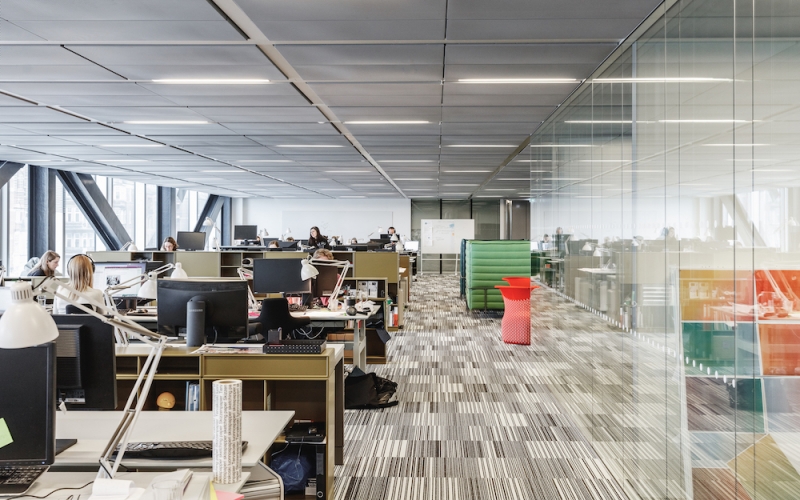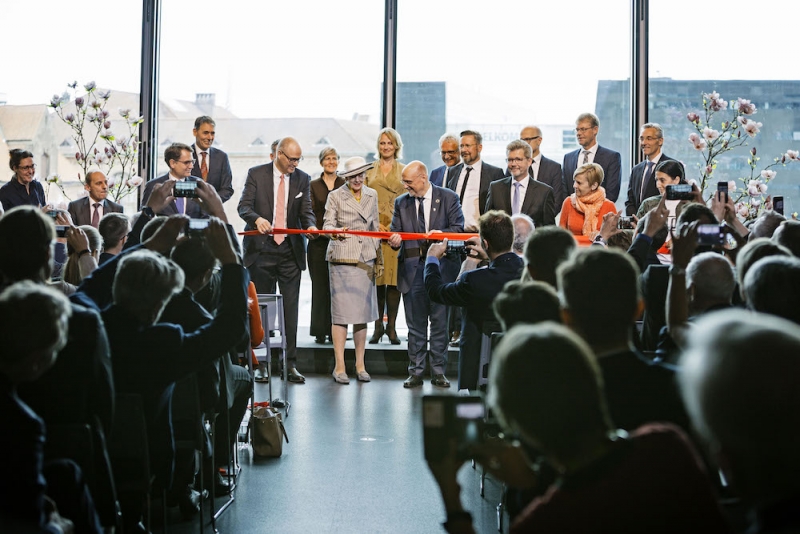
On May 7, 2018, the Danish Architecture Center welcomed the world to Copenhagen and to its long-awaited new home. DAC is Denmark’s national center for the development and dissemination of knowledge about architecture, building, and urban development. With the move, DAC has transformed into a larger and more visible organization that provides visitors an orientation to Danish architecture, design and livable cities. New DAC staff member Jen Masengarb, senior project manager for international visitors (and formerly the director of interpretation and research at the Chicago Architecture Foundation) reports for AAO members.
Preparing for a new chapter

The timeline of key moments in the history of Danish housing sits in front of a large staircase with seating, adjacent to the main hall in DAC's new home. Photo: Rasmus Hjortshøj, DAC.
The Danish Architecture Center recently celebrated a new chapter in the organization’s 32 year history – the same mission but in a new home and with a new identity. Housed originally in an 18th century brick warehouse, the DAC is now in the heart of a large multi-use new building – called BLOX – along Copenhagen’s main harbor. Designed by OMA’s Rotterdam office with partner Ellen van Loon, the Dutch firm won the architectural competition for the new building in 2009. DAC collaborated closely with Realdania, the building’s client/owner/developer throughout process.

Architects OMA designed a playground as part of the building, which opens onto a new public plaza. Photo: Søren Svendsen.
Designed as a ‘city within a city,’ the 75m x 75m building includes: co-working spaces for design-related companies, a restaurant, a fitness center, 22 apartments, underground parking and a built-in playground – in addition to DAC’s office space, exhibitions, galleries, main hall, conference rooms, education spaces, café and Design Shop. The DAC occupies about 30% of the total building, but is the most visible tenant.

DAC’s new workspace seats the 75+ staff. Photo: Søren Svendsen.
Our DAC staff of about 80 people moved into the unfinished building in early March 2018. Retail and café operations, education programs, and exhibitions continued for another two months in the original location, while construction continued on the new BLOX building.
In late April, about three weeks before the official opening day, our staff held a valuable day-long test event which led to a great insights and important understandings about visitor behavior, wayfinding, and operation logistics in the new building. We invited 500 pre-ticketed guests for the day and ran simultaneous events in each DAC space. The exhibitions weren’t fully installed, but the event provided an excellent teaser for local visitors who also agreed to be interviewed about their experiences and impressions that day which helped our staff see how the building functioned with people. (Each day we learn something new about how visitors organically use the spaces!)
About one week before the opening, our DAC marketing team launched a new logo and brand identity designed by Bruce Mau – as well as a new website, a new architectural guidebook to 100 of Copenhagen’s newest buildings, and a city-wide marketing campaign. DAC’s first podcast includes discussions on the building’s design, which has been a popular topic of debate among local residents, the press, and the architectural community. Investigating two key questions: Are we afraid of architectural change? And why do radical buildings often stir up debate?, the podcast explores the design of this new landmark as well as the conversation it has sparked throughout the city.
Opening a new Danish Architecture Center

Queen Margrethe II of Denmark cuts the ceremonial red ribbon on May 4, 2018 to open BLOX, new home of the Danish Architecture Center. Photo: Søren Svendsen.
Queen Margrethe II’s visit and ribbon cutting on May 4 kicked off a weekend of special events and festivities for the opening. The following day, a crowd of 1,500 invited guests from across Denmark and the world, heard from OMA’s Ellen van Loon and DAC’s director Kent Martinussen about the design process and the design thinking for the new building. Artist Olafur Eliasson discussed the inspiration for his installation, Multiple Shadow House.

Olafur Eliasson’s installation, Multiple Shadow House, delights visitors young and old. Photo: DAC and Rasmus Hjortshøj.
DAC convened a panel of leaders from architecture centers across the globe – many of them AAO members – to discuss the role of architectures centers in 21st century cities. Photo: Jen Masengarb, DAC
DAC also invited the heads of several other architecture centers and AAO members for a unique panel discussion Lynn Osmond, Chicago Architecture Foundation; Francis Rambert, Institut francais d'architecture; Ng Lye Hock Larry, Urban Redevelopment Authority, Singapore; Peter Murray, New London Architecture; and Rebecca Bailey, Historic Environment Scotland discussed the role of the 21st century architecture center in cities today.

Opening weekend festival (May 5-6) at BLOX, the Danish Architecture Center’s new home. Photo: Søren Svendsen.
The following day we helped open the building to the city with free Sunday admission to welcome the public. More than 17,000 people enjoyed music, dancing, food and festive events in the plaza, while more than 10,000 visitors toured the exhibitions that day.
Three new exhibitions – targeted to both local and international visitors – have opened to strong reviews. In addition to Olafur Eliasson’s interactive installation, Welcome Home investigates the major historical events that have shaped housing in Denmark. It also examines current challenges as well as innovative proposals that are impacting the future of housing. Made in Denmark invites visitors to consider how and why design is so ingrained in Danish culture, through a series of short videos and furniture settings.
Lessons from the first weeks in our new home
DAC’s Exhibition Hosts greet visitors and engage in discussions about design in Denmark and the exhibition. Photo: Jen Masengarb, DAC
With a larger and more visible location, and as we anticipate an increase in visitors, the DAC team recognized the need for ‘architectural ambassadors’ – staff who would welcome guests and provide a critical interpretive link to the exhibitions. Several local university students in architecture and urban planning were recruited to serve as DAC’s first Exhibition Hosts. They float throughout the spaces answering questions and often engaging in deep conversations with visitors about architecture and design. In addition to being the eyes and ears in the spaces, the Exhibition Hosts have been keeping track of the types of questions visitors ask and the big themes they want to discuss.
Local visitors, not surprisingly, are most interested in talking about the building. In addition to discussing the history of the site and its design and construction, they often want to debate the choice of a non-Danish architect for the project. And the Welcome Home exhibition has also provided many opportunities for local Danes to reflect on how the country’s housing policies have shaped everyday life.
International visitors have very different questions for us, of course. The most popular question from visitors often centers on how and where they can visit the buildings by Denmark’s most well-known contemporary architect – Bjarke Ingels Group (BIG). But on a deeper level, time and again, we have observed foreign visitors trying to truly understand the roots of design in Denmark – its impact on everyday life at home and in cities – and how design decisions here have been shaped by cultural and societal values. With most guests visiting Copenhagen for an average of just 2.5 days, these interactions with DAC’s Exhibition Hosts may be the only opportunity to have this type of critical conversation – with a native Dane – about the city’s built environment.
 DAC’s major exhibition, Welcome Home, explores the past, present and future of housing in Denmark. Photo: DAC and Rasmus Hjortshøj.
DAC’s major exhibition, Welcome Home, explores the past, present and future of housing in Denmark. Photo: DAC and Rasmus Hjortshøj.And since the Exhibition Hosts track these conversations each day, their detailed feedback has led to new insights for our staff. This information will continue to shape how we can best serve our guests – through future tours, printed resources, web content, wayfinding, programs and exhibition interpretation.
